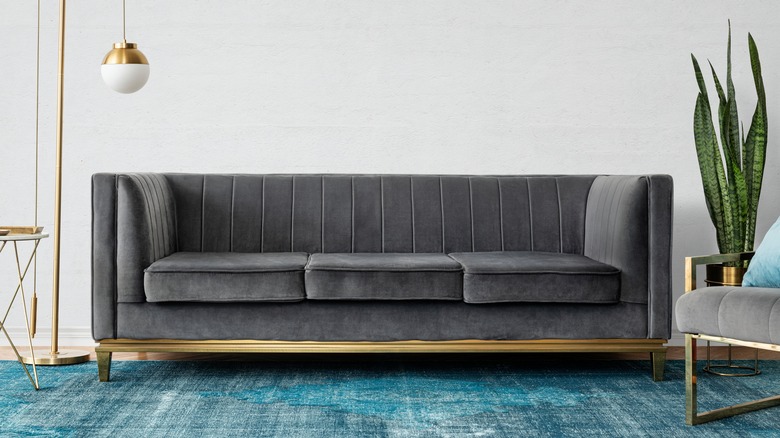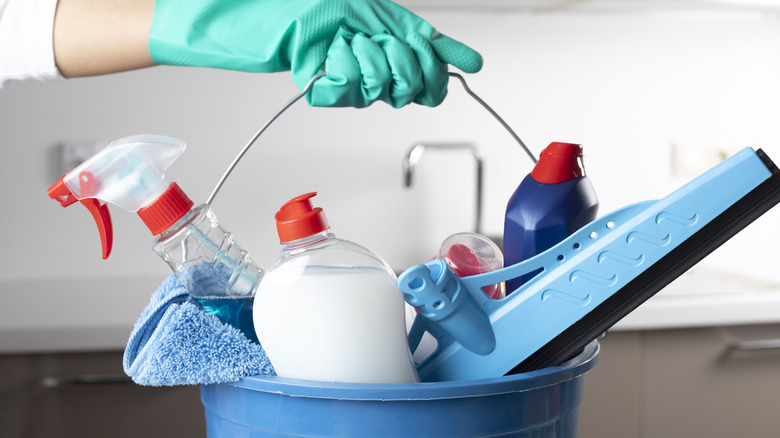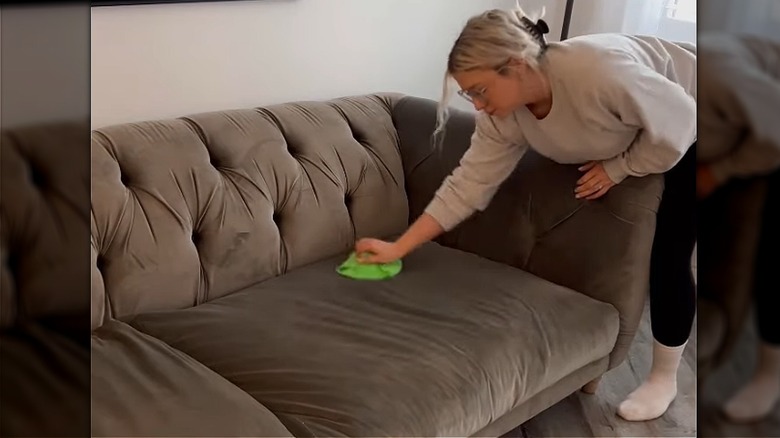The Biggest Mistake To Avoid When Cleaning A Velvet Couch
Sofas upholstered in velvet can give your home a classy and elegant look. However, before you rush out and buy a velvet couch, you should keep in mind that you may have to take extra steps to keep it looking brand new. Overall, velvet isn't actually that high-maintenance in comparison to other fabrics. Contemporary synthetic velvet, which is the most common type you'll find on the market today, is also a lot more durable than silk or cotton velvet types. However, it can be more difficult to keep clean because you need to use the right products on it, and making the mistake of using the wrong product (or products) to clean a velvet couch could be disastrous.
Whether you're drawn to natural products or prefer all-purpose cleaners to get the job done, it's vital that you always check if an item is okay to use before cleaning with it. If you do end up trying out a product that isn't suitable for your sofa, you could end up with furniture that's discolored and patchy — obviously something you want to avoid at all costs. Luckily, there are products you can use that will get your sofa looking polished without the risk of any damage.
Prevent discoloration and fading of your velvet sofa by avoiding these cleaners
As there are many cleaners out there, we've narrowed it down to two types that you should definitely steer clear of when it comes to your velvet sofa. First, do not use cleaners that contain heaps of chemicals, specifically bleach-based products. In some cases, chemicals are fine and help to clean furniture thoroughly. However, bleach can discolor your velvet couch, potentially leaving it looking dull and faded. Instead of chancing it, it's best to avoid using bleach-based products entirely on velvet.
You shouldn't just avoid straight bleach, either. The rule of not using harsh chemicals on velvet also applies to not cleaning with all-purpose solutions. This type of cleaner could have bleach as the base which, as mentioned, can discolor velvet. It may not be obvious at first that a multi-surface cleaner contains bleach, so it's best to avoid them altogether. We also recommend getting into the habit of reading ingredient lists, even if the product says it's suitable for all materials and surfaces, as this will guarantee your sofa never gets damaged.
Clean with these products instead
Now that you know what not to clean your couch with, you may be wondering what to use in place of bleach-based and all-purpose products. Rather than harsh cleaners, use a specialist velvet product to get your sofa looking new again. After vacuuming the surface, simply apply a small amount of the cleaner to a soft cloth and dab at over any stained or visibly-dirty areas. Never pour a large amount of any product onto your sofa and never rub or scrub it into the velvet — a blotting motion is ideal unless you are otherwise directed by a product's specific instructions.
If you can't get your hands on a velvet upholstery cleaner, make a safe DIY velvet cleaning solution with liquid dishwasher detergent or mild dish soap and water. Add a small amount of cleaner to some warm water and then follow the same steps you would if using a velvet cleaner. You may need to repeat the process a few times for particularly-stubborn stains. If any stains come with debris, attempt to remove them with a butter knife before going in with the detergent solution. When you have finished cleaning, let the couch dry naturally. Using items like a hairdryer to speed up the drying process could also damage your sofa, so you'll want to avoid this as well. Finish the process by plumping up any sections that are looking a little flat with a soft-bristled brush.


